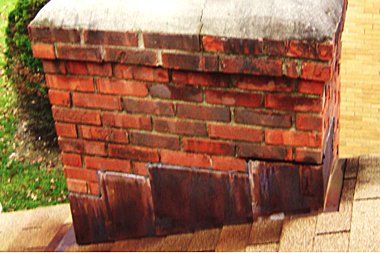4 Types of Moisture-Related Chimney Damage
 Chimney damage caused by moisture is common throughout our service area, from Galena, IL, to Madison, WI, to Dubuque, IA. One of the most important reasons to get an annual chimney inspection is to determine if there is an unseen problem, such as water damage, and get the issue repaired as quickly as possible. The following are four moisture-related problems common in chimneys:
Chimney damage caused by moisture is common throughout our service area, from Galena, IL, to Madison, WI, to Dubuque, IA. One of the most important reasons to get an annual chimney inspection is to determine if there is an unseen problem, such as water damage, and get the issue repaired as quickly as possible. The following are four moisture-related problems common in chimneys:
Mortar Deterioration
The frequent cycles of freezing and thawing that we experience in the upper Midwest in winter can cause deterioration of the mortar on a masonry chimney. Another common situation is that there will be too much water on the roof flowing against the chimney when it rains. The continuous deluge damages the mortar, which also affects the masonry.
Our certified chimney technicians have the tools and training to repair mortar using a process called “tuckpointing.” The damaged mortar and bricks are removed and then replaced during the process. The repairs are made in such a way that the chimney will be restored to look like new. Tuckpointing ensures that the mortar joints are durable and resistant to water, and the new mortar blends in well with areas that didn’t require repair.
The roof water can be averted from the chimney if a “cricket” is installed. Our chimney technicians can perform this and all other work needed to repair and protect your venting system.
Spalling
Bricks absorb moisture because of the material they are made with. If water gets trapped in the masonry, spalling can occur, which means the surface of the masonry breaks off due to the freezing and thawing of the moisture inside. You can spot signs of spalling because bits of masonry will fall onto the roof or ground below. If enough bricks are damaged, the entire structural component of the chimney could collapse.
One way to help prevent spalling is to waterproof the chimney. Waterproofing prevents excess moisture from entering into the chimney, but it also allows moisture that does get inside to escape.
Liner Deterioration
Another type of destruction caused by moisture is deterioration of the chimney liner. Cracks in the flue often occur due to a combination of creosote and moisture. Once the flue is cracked, other problems can be expected, such as damage to wallpaper and ceilings.
A cracked flue liner must be replaced; otherwise, using the fireplace could start a house fire. Whether water enters due to a damaged chimney crown, as a result of mortar problems, or for some other reason, it means trouble for the venting system.
Rusting

Rusting Chimney
If, for instance, you don’t have a chimney cap, rainwater can freely flow into the chimney and cause problems. The damper or firebox can become rusted. A damaged damper doesn’t usually seal properly, which causes a whole different kind of problem; namely, heat will escape through the chimney during winter and cool air will escape in summer.The earlier you deal with moisture damage in the chimney, the better, since your chimney will experience less deterioration and costs of repair will be less than if the problem was allowed to get worse.
Contact us today for your annual chimney inspection or if you see evidence of moisture damage, whether you live in Southwest Wisconsin, Northeast Iowa or Northwest Illinois.
For your Fireplace, Stove, Patio or Chimney needs
please call one of our Sponsoring Businesses.
Chimney Specialists, Inc
869 Main Street, Highland, WI 53543
(608) 929-4887
Dubuque Fireplace & Patio
925 Century Drive, Dubuque, IA 52002
(563) 582-5156







